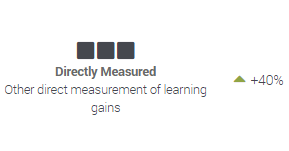How do report variances work?
What is report variance, how is it calculated, and what does it mean? Learn more in this support article.
What is report variance?
Report variance shows percentage change of forecasted vs. current forecast or final social impacts. In other words, it provides information on the difference between what the program originally projected to achieve and their most recent update.

Note that a variance listed as "n/a" means that either there were not two values to do a calculation OR that the two values provided did not change so there is no variance.
How is report variance calculated?
For each indicator in a logic model, variance is calculated as such: (Increase or Decrease) / (Initial Forecast) x 100. The variance calculation will always capture the percent change between the very first predicted value and the most recent value reported.
Because a variance calculation requires two values, an Initial Report will never include a variance. Variance will appear on Interim or Final Reports in cases where the user is updating an earlier version of the report. Specifically:
- If a user completes an Initial Report and later completes an Interim Report, the published Interim Report will show the variance as: -[(Initial Report Value - Interim Report Value) / (Initial Report Value)] x 100.
- If a user completes an Interim Report and later completes a Final Report, the published Final Report will show the variance as: -[(Interim Report Value - Final Report Value) / (Interim Report Value)] x 100.
- If a user completes an Initial Report and later completes a Final Report, the published Final Report will show the variance as: -[(Initial Report Value - Final Report Value) / (Initial Report Value)] x 100.
- If a user completes an Initial, Interim, AND Final Report, the variances will show as such:
- Initial Report: no variance
- Interim Report: -[(Initial Report Value - Interim Report Value) / (Initial Report Value)] x 100
- Final Report: -[(Initial Report Value - Final Report Value) / (Initial Report Value)] x 100
- If a user completes ONLY an Initial, Interim, or Final report, no variance can be calculated.
What does report variance mean?
Report variance can be a helpful tool in understanding the change of forecasted social impacts throughout the life cycle of a program. It assists in identifying if the program accomplished more or less than they originally predicted. It may be interesting to review variances across a portfolio of investments to understand if there are any trends in ability to accurately predict social impacts.
It's also important to recall that Interim Reports do not capture programmatic progress to date. Interim reports capture updated forecasts of what the program expects to accomplish based on how implementation has gone so far. Only Final Reports provide achieved programmatic results.